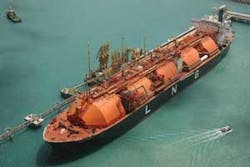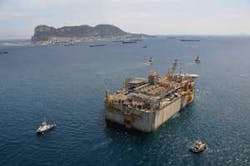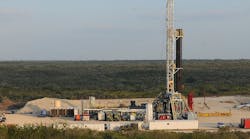The LNG industry in the past year has passed more technology milestones in its rapidly evolving recent history.
Offshore-based discharge of LNG into regional South American markets made an appearance in June 2008 and again in early 2009. The world’s first fixed offshore terminal was installed in Europe in late 2008. And the world’s largest LNG carrier, the first of the Q-Max series of tankers was commissioned and delivered to its Qatari owner.
Argentina, Brazil
Floating LNG continued to evolve from the foundation set by Excelerate Energy.
In June 2008, the company announced delivery of Argentina’s first LNG cargo to the newly constructed import facility at the port city of Bahía Blanca, about 400 miles south of Buenos Aires.
Natural gas, revaporized from LNG, flowed through the Bahía Blanca GasPort directly into Argentina’s gas distribution system. The GasPort was South America’s first LNG receiving facility and the world’s second dockside regasification facility after Excelerate’s installation at Teesside, UK.
At the Bahía Blanca, the company’s LNG regasification vessel Excelsior docked alongside a dedicated jetty and connected to an onshore natural gas pipeline via Excelerate’s specially designed dockside high-pressure gas off-loading arm. LNG cargoes will be supplied to the docked vessel via traditional LNG carriers using Excelerate’s ship-to-ship LNG transfer protocol, said the comapny.
The jointly developed Bahía Blanca GasPort allows delivery of up to 400 MMcfd with initial capacity to import up to three LNG cargoes/month, each to contain about 3 bcf of natural gas.
Earlier this year in Brazil, Petrobras received the world’s first floating storage and regasification unit vessel, the Golar Spirit, following commissioning tests on the vessel’s regasification trains (OGJ, Mar. 16, 2009, p. 64).
Called an “FSRU,” the vessel went into service at Petrobras’s offshore LNG terminal, off Pecem, Ceara state. Each of its three regas units can send out up to about 130 MMcfd, with two units normally working while the third remains on standby.
At Pecem, Petrobras placed LNG unloading arms and high-pressure gas arms on a pier. An LNG carrier berths on the side away from the FSRU and unloads its cargo with the unloading arms onto the FSRU, which would then regasify the LNG and move the natural gas ashore via the HP gas arms (Fig. 1).
Later in 2009, Petrobras will use the Golar Spirit to commission a second offshore LNG terminal, in Guanabara Bay, Rio de Janeiro. In the meantime, Blackwell said a second LNG carrier, the Golar Winter, is undergoing conversion at the Keppel yard.
In late June of last year, Shell Gas & Power Developments BV issued a formal invitation to tender for front-end engineering and design and engineering, procurement, and construction of a 3.5 million tpy floating plant.
The tender was issued to three consortia consisting of engineering and shipyard contractors selected after a prequalification exercise undertaken by Shell. Bids were to be announced by yearend 2008 with award of contracts possible during 2009. At OGJ press time in mid-March, no announcements had been made.
Shell said it had invested in development of FLNG technology over the last 10 years, and, at the time of this announcement, claimed to have been looking closely at several potential developments, particularly in Asia-Pacific.
Terminal, vessel delivered
Two other industry innovations moved from fabrication to installation.
In September last year, the world’s first offshore LNG terminal arrived at final location off the Italian coast (Fig. 2).
The Adriatic terminal will store and regasify LNG to deliver 775 MMcfd (8 billion cu m/year) when it reaches full operations later in 2009.
The terminal left its construction site in Algeciras, Spain, in late August on the 1,700-mile trip, arriving Sept. 15. The terminal was positioned about 10 miles off Porto Levante, Italy, in the Adriatic Sea, in about 95 ft of water and was being connected via pipeline to Italy’s natural gas grid.
The Adriatic LNG project is owned by ExxonMobil Italiana Gas, Qatar Terminal Ltd. (a Qatar Petroleum 100%-owned subsidiary), and Edison. The terminal will receive natural gas produced from Qatar’s North field, the largest nonassociated natural gas field in the world.
Finally, last year saw delivery of the first of the world’s largest LNG carriers.
Qatargas Operating Co. Ltd. and its shipping company Nakilat took possession of the LNG Q-Max Mozah (see cover). The 266,000-cu m vessel was built at Samsung Heavy Industries’ shipyard on Geoje Island, South Korea. It is Nakilat’s flagship and was the first of 14 Q-Max vessels on order and the first of 25 wholly owned LNG carriers in its fleet of 54 vessels being built in the Korean shipyards for Qatar’s LNG expansion projects, according to the company.
Mozah will ship LNG produced by Qatar Liquefied Gas Co. Ltd. II (“Qatargas 2”) to markets in Europe.
The company said the Q-Max has 80% more capacity than conventional LNG carriers with about 40% lower energy requirements due to the economies of scale created by its size and the efficiency of the engines.




